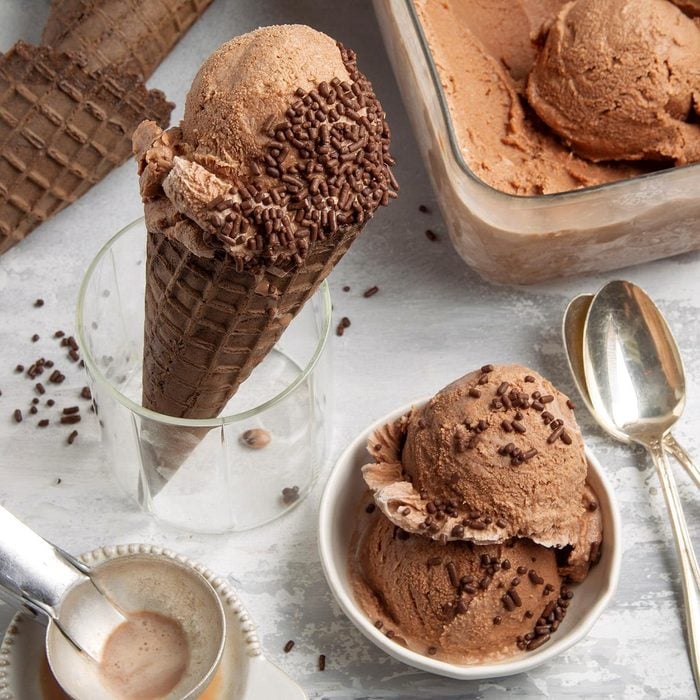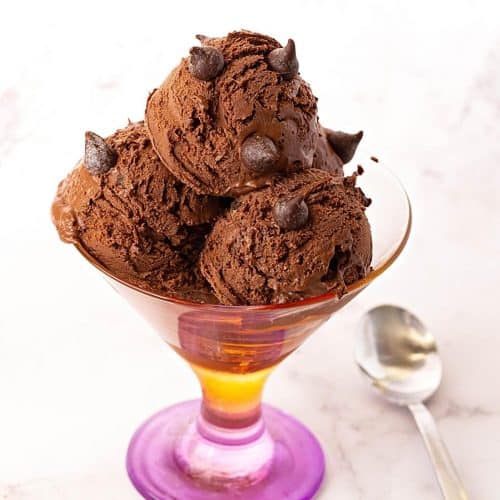Ice cream is one of the most beloved desserts worldwide, with chocolate being a top favorite flavor for many. However, like all foods, ice cream has a shelf life. Understanding how long chocolate ice cream lasts and the factors that affect its longevity can help you enjoy this treat safely and at its best quality. In this comprehensive guide, we’ll explore the shelf life of chocolate ice cream, signs of spoilage, storage tips, and more.
The Shelf Life of Chocolate Ice Cream

Unopened chocolate ice cream: When stored at a constant temperature of zero degrees Fahrenheit (-18 degrees Celsius), unopened chocolate ice cream can last for about 2-3 months. During this period, it retains its optimal taste and texture. However, it remains safe to eat for up to 4 months, though the quality may decline after the initial 2-3 months.
Opened chocolate ice cream: Once you open a tub of chocolate ice cream, it stays fresh for about 6 weeks if stored properly at zero degrees Fahrenheit. Beyond this period, it may still be safe to eat for up to 3-4 months, but the taste and texture will likely degrade.
Factors Affecting Shelf Life

Several factors influence the shelf life of chocolate ice cream, including:
Temperature Consistency
Maintaining a constant, cold temperature is crucial for preserving ice cream. Fluctuations in temperature can cause ice cream to melt and refreeze, leading to the formation of ice crystals and a change in texture.
Exposure to Air
When ice cream is exposed to air, it can develop freezer burn. This occurs when moisture evaporates and forms ice crystals on the surface. Freezer burn affects the taste and texture, making the ice cream less enjoyable.
Packaging Quality
The quality of the packaging plays a significant role in how long ice cream lasts. Tightly sealed containers prevent air and moisture from entering, which helps maintain freshness.
Ingredients
The ingredients in chocolate ice cream can also impact its shelf life. Higher-quality ingredients and fewer additives generally mean the ice cream will retain its taste and texture longer.
Signs of Spoiled Chocolate Ice Cream
:max_bytes(150000):strip_icc()/No-Churn-Chocolate-Ice-Cream-FT-RECIPE0323-adc3b200b52e4a3dbf5f3345dc866fbc.jpg)
It’s essential to recognize the signs of spoiled ice cream to avoid foodborne illness. Here are some common indicators that your chocolate ice cream may have gone bad:
Ice Crystals
The presence of ice crystals on the surface of the ice cream or under the lid is a sign of freezer burn. While it doesn’t necessarily mean the ice cream is unsafe to eat, it indicates a decline in quality.
Texture Changes
Spoiled ice cream may become gooey or develop a gritty texture. These changes result from the melting and refreezing process, which affects the ice cream’s consistency.
Off Smell or Taste
If the ice cream has an unusual smell or taste, it’s best to discard it. These off flavors and odors can be a sign of bacterial growth or contamination.
Discoloration
Any noticeable change in color, such as darkening or yellowing, can indicate that the ice cream is no longer fresh.
How to Store Chocolate Ice Cream Properly

Proper storage is key to extending the shelf life of your chocolate ice cream. Follow these tips to keep your ice cream fresh and delicious for as long as possible:
Keep It Cold
Store ice cream at zero degrees Fahrenheit (-18 degrees Celsius) or lower. Place it in the coldest part of the freezer, typically the back, to avoid temperature fluctuations caused by opening the freezer door.
Seal Tightly
Ensure the ice cream container is tightly sealed after each use to minimize exposure to air and moisture. If the original packaging is damaged, transfer the ice cream to an airtight container.
Use Freezer Paper or Plastic Wrap
For unopened ice cream, wrapping the tub with freezer paper or plastic wrap adds an extra layer of protection against freezer burn.
Avoid Frequent Opening
Limit the number of times you open the ice cream container to reduce the exposure to warm air. This helps maintain a consistent temperature inside the container.
Tips for Buying and Handling Ice Cream

To maximize the shelf life of chocolate ice cream, consider these tips when purchasing and handling it:
Check Expiration Dates
Always check the expiration date on the ice cream container before purchasing. Choose the one with the longest shelf life to ensure you have ample time to enjoy it.
Transport with Care
When buying ice cream, try to make it one of the last items you pick up before heading to the checkout. Use an insulated bag or cooler to keep it cold on the way home, especially if you have a long drive.
Avoid Melt and Refreeze
If the ice cream melts significantly before you get it home, it’s best to consume it right away rather than refreezing. Refreezing can lead to texture changes and reduce the quality.
Portion Control
If you only want a small portion of ice cream, consider scooping it into a separate bowl and returning the container to the freezer promptly. This minimizes the time the ice cream is exposed to warmer air.
Understanding Freezer Burn

Freezer burn is a common issue that affects the quality of ice cream. Here’s what you need to know about freezer burn and how to prevent it:
What Is Freezer Burn?
Freezer burn occurs when moisture in the ice cream evaporates and forms ice crystals on the surface. This happens when the ice cream is exposed to air, often due to an improperly sealed container or frequent temperature changes.
Effects of Freezer Burn
Freezer burn affects the texture and taste of ice cream, making it dry and less enjoyable. While it doesn’t necessarily make the ice cream unsafe to eat, it does compromise the overall quality.
Preventing Freezer Burn
To prevent freezer burn, always store ice cream in a tightly sealed container and minimize exposure to air. Wrapping the container with freezer paper or plastic wrap can provide additional protection.
The Role of Ingredients in Shelf Life
:max_bytes(150000):strip_icc()/easy-chocolate-ice-cream-recipe-1945798-hero-01-45d9f26a0aaf4c1dba38d7e0a2ab51e2.jpg)
The ingredients in chocolate ice cream can influence its shelf life and quality. Here’s how different components affect storage:
Dairy
Dairy products like milk and cream are prone to bacterial growth, which can shorten the shelf life of ice cream. High-quality dairy ingredients with fewer additives tend to have better taste and texture retention.
Sweeteners
Sweeteners like sugar and corn syrup help to preserve the texture of ice cream by lowering the freezing point and preventing large ice crystals from forming. However, too much sugar can lead to a overly sweet taste and affect the ice cream’s overall quality.
Stabilizers and Emulsifiers
Stabilizers and emulsifiers, such as guar gum and lecithin, are added to ice cream to maintain a smooth texture and prevent separation of ingredients. These additives can help extend the shelf life by maintaining consistency during storage.
Flavorings
Natural flavorings, like cocoa and vanilla, generally provide better taste and longer-lasting quality compared to artificial flavorings. The type and quality of flavorings can impact how well the ice cream holds up over time.
Homemade vs. Store-Bought Chocolate Ice Cream
The shelf life of homemade chocolate ice cream differs from store-bought varieties due to differences in ingredients, preparation methods, and storage.
Homemade Chocolate Ice Cream
Homemade ice cream, typically made without preservatives, has a shorter shelf life. When stored at zero degrees Fahrenheit, homemade ice cream lasts about 2-3 weeks. It’s best to consume it within this timeframe for optimal taste and texture.
Store-Bought Chocolate Ice Cream
Store-bought ice cream often contains stabilizers, emulsifiers, and preservatives that extend its shelf life. These additives help maintain quality for up to 2-3 months when unopened and 6 weeks when opened, provided it’s stored properly.
FAQs About Chocolate Ice Cream Shelf Life

Can You Eat Ice Cream Past the Expiration Date?
While you can technically eat ice cream past its expiration date, the quality may decline significantly. It’s best to use the expiration date as a guideline and rely on your senses to determine if the ice cream is still good.
How Can You Tell If Ice Cream Has Gone Bad?
Look for signs like ice crystals, changes in texture, off smells or tastes, and discoloration. If you notice any of these, it’s best to discard the ice cream to avoid potential foodborne illness.
Is It Safe to Eat Ice Cream with Freezer Burn?
Ice cream with freezer burn is safe to eat but may not taste as good. The texture can become dry and gritty, making it less enjoyable.
Can You Refreeze Melted Ice Cream?
It’s not recommended to refreeze melted ice cream, especially if it has been melted for over an hour. Refreezing can lead to texture changes and increase the risk of bacterial growth.
How Long Does Ice Cream Last in a Power Outage?
If the power outage lasts less than 4 hours and the freezer remains closed, ice cream should remain safe. For longer outages, it’s best to check the ice cream’s texture and smell before deciding whether to consume it.
Fun Facts About Chocolate Ice Cream

History of Chocolate Ice Cream
Chocolate ice cream dates back to the 17th century. It’s believed to have been created in Naples, Italy, and has since become one of the most popular ice cream flavors worldwide.
Popularity of Chocolate Ice Cream
Chocolate ice cream is consistently one of the top three favorite flavors in the United States, alongside vanilla and strawberry.
Unique Chocolate Ice Cream Varieties
Chocolate ice cream comes in many varieties, from classic chocolate to rich dark chocolate and innovative flavors like chocolate fudge brownie or chocolate mint chip.
Conclusion
Understanding how long chocolate ice cream lasts and the factors that affect its shelf life can help you enjoy this delicious treat safely and at its best quality. By storing ice cream properly, recognizing signs of spoilage, and following best practices for buying and handling, you can extend the shelf life of your favorite chocolate ice cream. Whether homemade or store-bought, savor each scoop while it’s fresh and delicious!






